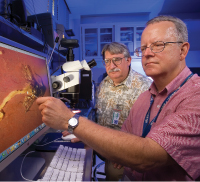
Houseflies and Salmonella: The role of flies in the spread of salmonella examined
By Sharon Durham Agricultural Research Service Information Staff USDA
Features Business & Policy Consumer IssuesThe role of flies in the spread of salmonella examined
It’s common knowledge that
houseflies are carriers of disease. That’s why there’s such widespread
effort to keep them out of our kitchens and away from our food.
 |
| AN INSIDE LOOK Using a dissecting scope, entomologist Chris Geden (left) and microbiologist Peter Holt identify which of a fly’s internal organs should be examined for Salmonella enteritidis contamination. Photos by Stephen Ausmus |
But could the common housefly, Musca domestica, also play a role in spreading food poisoning bacteria such as Salmonella enteritidis to chickens – and their eggs – even before the foods get into the marketing chain?
Microbiologist Peter S. Holt and entomologist Christopher J. Geden were curious. Holt works in the Egg Safety and Quality Research Unit at ARS’s Richard B. Russell Research Center in Athens, Georgia, while Geden is at the agency’s Center for Medical, Agricultural, and Veterinary Entomology in Gainesville, Florida.
“We decided to investigate whether infected hens could pass the infection on to flies,” says Holt, “and whether those flies could then infect healthy birds. If so, we wanted to see how that happens and where the Salmonella bacteria appear on – and in – the flies.”
In three experiments, Holt placed chickens in individual, adjacent laying cages. Geden delivered fly pupae just 48 hours short of their emergence as flies; these were placed in an open box in the bird room. Three days later the hens were challenged with Salmonella.
“We found that about half the houseflies became colonized with Salmonella soon after emergence,” says Holt. The bacteria were detected in and on 45-50 per cent of the flies within the first 48 hours, and levels remained at 50 per cent or higher for the following five days.
BEST IF INGESTED
Next, the researchers exposed uninfected hens to the newly infected flies. They found that just being around the contaminated flies didn’t cause healthy birds to become infected, but eating infected flies did.
Print this page